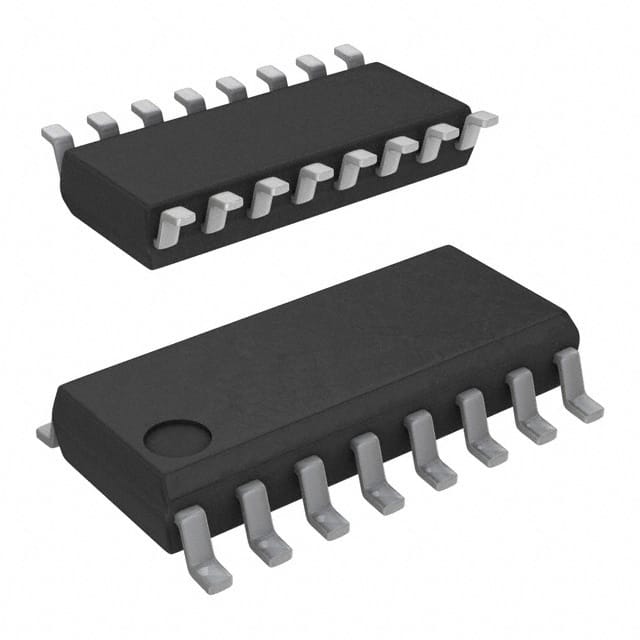Consulte las especificaciones para obtener detalles del producto.

SN74LVC138AQDRQ1
Overview
- Category: Integrated Circuit (IC)
- Use: Decoder/Demultiplexer
- Characteristics:
- Low-voltage CMOS technology
- High-speed operation
- Low power consumption
- Package: TSSOP-16
- Essence: A decoder/demultiplexer IC that converts a binary input into a corresponding output line
- Packaging/Quantity: Tape and reel, 2500 units per reel
Specifications
- Supply voltage range: 1.65V to 5.5V
- Input voltage range: 0V to VCC
- Output voltage range: 0V to VCC
- Maximum input current: ±20mA
- Maximum output current: ±32mA
- Operating temperature range: -40°C to +125°C
Pin Configuration
The SN74LVC138AQDRQ1 has a total of 16 pins, which are assigned as follows:
- GND (Ground)
- Y0 (Output 0)
- Y1 (Output 1)
- Y2 (Output 2)
- Y3 (Output 3)
- Y4 (Output 4)
- Y5 (Output 5)
- Y6 (Output 6)
- Y7 (Output 7)
- E1 (Enable 1)
- E2 (Enable 2)
- A0 (Address 0)
- A1 (Address 1)
- A2 (Address 2)
- VCC (Supply Voltage)
- GND (Ground)
Functional Features
- Converts a 3-bit binary input into one of the eight output lines
- Enables individual output lines based on the combination of address inputs
- Low-power consumption due to CMOS technology
- High-speed operation for efficient decoding
Advantages and Disadvantages
Advantages: - Low-voltage operation allows compatibility with various systems - High-speed operation enables quick decoding - Low power consumption extends battery life in portable devices
Disadvantages: - Limited to 3-bit binary input, restricting the number of output lines - Not suitable for applications requiring complex decoding
Working Principles
The SN74LVC138AQDRQ1 is a decoder/demultiplexer IC that operates based on the combination of address inputs (A0, A1, A2). The three address inputs represent a 3-bit binary code, which determines the corresponding output line. The enable inputs (E1, E2) control the activation of the output lines.
When the enable inputs are active (low), the decoder/demultiplexer decodes the binary input and activates the corresponding output line. The selected output line goes low, while all other output lines remain high. This functionality allows the IC to be used in various applications where decoding and demultiplexing are required.
Detailed Application Field Plans
The SN74LVC138AQDRQ1 finds applications in various fields, including:
- Address decoding in microcontrollers and microprocessors
- Memory selection in digital systems
- Data routing in communication systems
- Signal demultiplexing in audio/video equipment
- Control signal generation in industrial automation
Detailed and Complete Alternative Models
- 74HC138: Similar decoder/demultiplexer IC with TTL logic levels
- CD74HCT138: Decoder/demultiplexer IC with Schmitt-trigger inputs
- SN74LS138: Decoder/demultiplexer IC with higher voltage tolerance
These alternative models provide similar functionality but may have different characteristics and specifications. It is important to consider the specific requirements of the application when selecting an alternative model.
Word count: 405 words
Enumere 10 preguntas y respuestas comunes relacionadas con la aplicación de SN74LVC138AQDRQ1 en soluciones técnicas
Sure! Here are 10 common questions and answers related to the application of SN74LVC138AQDRQ1 in technical solutions:
1. What is SN74LVC138AQDRQ1? - SN74LVC138AQDRQ1 is a 3-to-8 line decoder/demultiplexer IC (integrated circuit) that can be used in various digital logic applications.
2. What is the purpose of SN74LVC138AQDRQ1? - The purpose of SN74LVC138AQDRQ1 is to decode a 3-bit binary input and activate one of the eight output lines based on the input combination.
3. What voltage levels does SN74LVC138AQDRQ1 support? - SN74LVC138AQDRQ1 supports voltage levels from 1.65V to 5.5V, making it compatible with both low-voltage and standard CMOS logic families.
4. How many inputs does SN74LVC138AQDRQ1 have? - SN74LVC138AQDRQ1 has three input pins (A0, A1, and A2) that accept binary inputs.
5. How many output lines does SN74LVC138AQDRQ1 have? - SN74LVC138AQDRQ1 has eight output lines (Y0 to Y7) that can be activated based on the input combination.
6. Can SN74LVC138AQDRQ1 be cascaded to increase the number of outputs? - Yes, multiple SN74LVC138AQDRQ1 ICs can be cascaded together to increase the number of outputs for larger decoding applications.
7. What is the maximum frequency at which SN74LVC138AQDRQ1 can operate? - SN74LVC138AQDRQ1 can operate at a maximum frequency of 100 MHz, making it suitable for high-speed digital applications.
8. Does SN74LVC138AQDRQ1 have any built-in protection features? - Yes, SN74LVC138AQDRQ1 has built-in ESD (electrostatic discharge) protection on all inputs and outputs, ensuring reliability in harsh environments.
9. Can SN74LVC138AQDRQ1 be used in automotive applications? - Yes, SN74LVC138AQDRQ1 is specifically designed for automotive applications and meets the AEC-Q100 automotive qualification standards.
10. What package options are available for SN74LVC138AQDRQ1? - SN74LVC138AQDRQ1 is available in a small-sized, surface-mount package called SOIC-16 (Small Outline Integrated Circuit).

